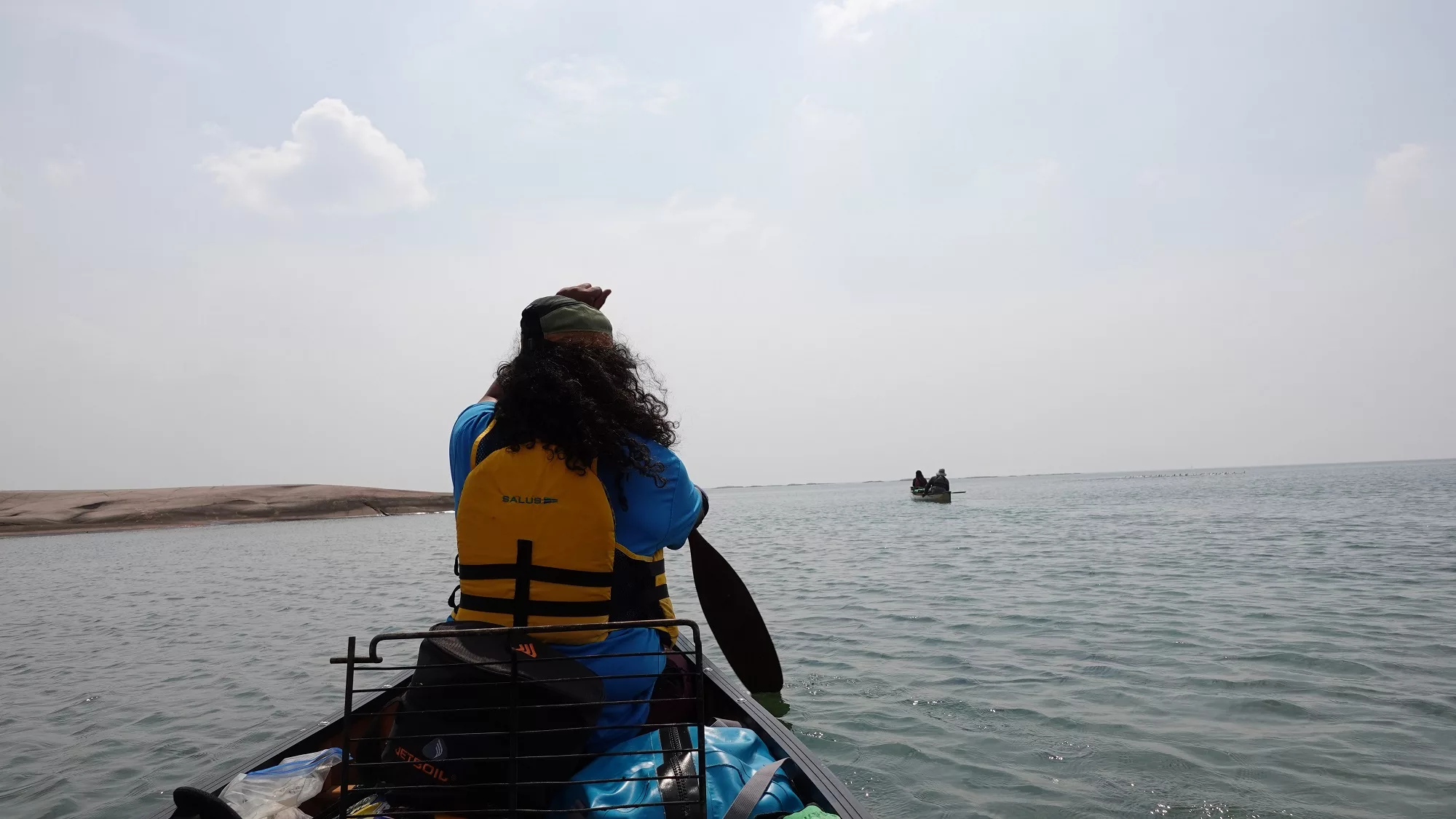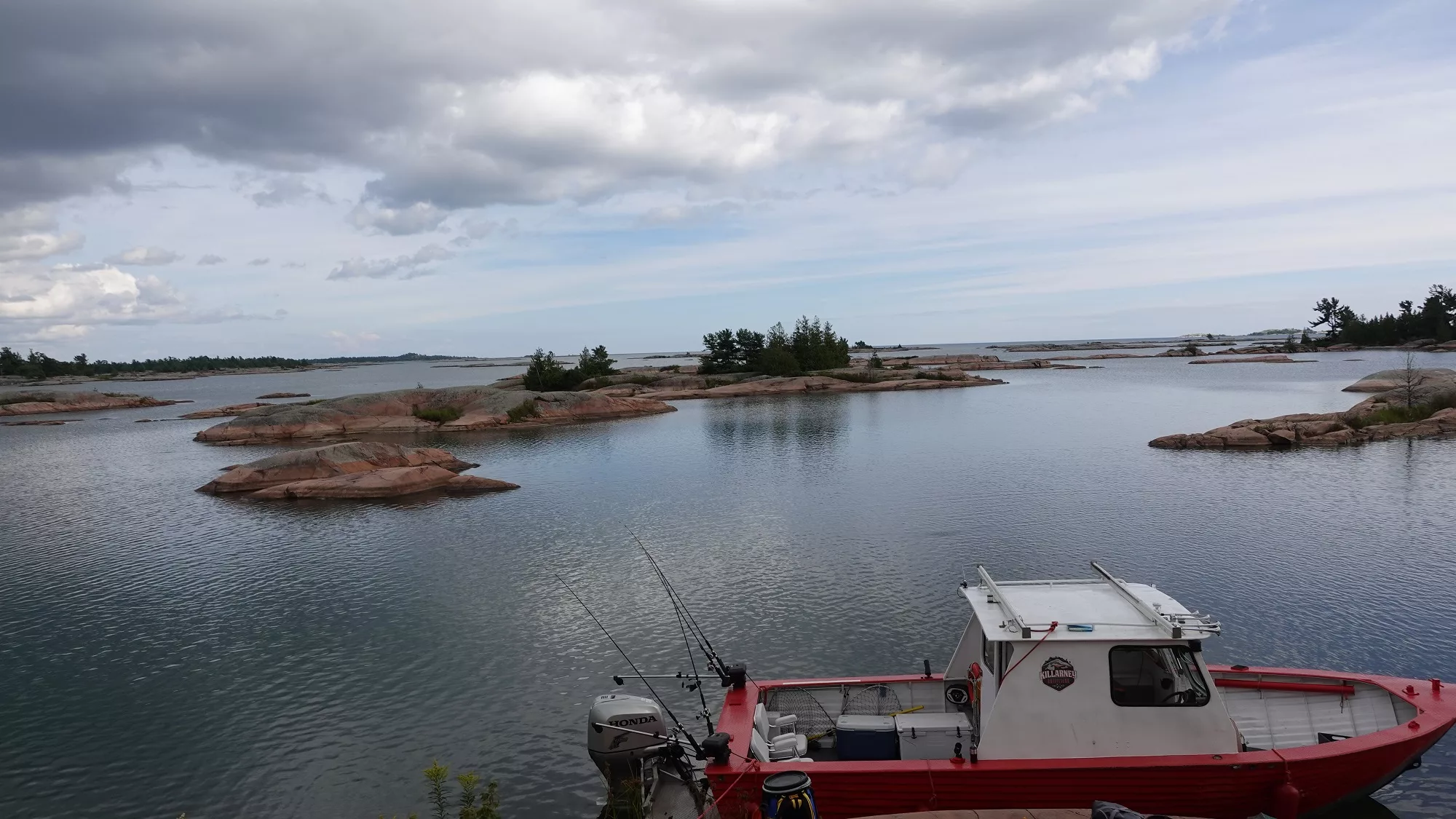The Happy Camper: UK Paddlers Experience Georgian Bay’s Philip Edward Island

Ray Goodwin, a top paddling coach in the UK, has taken care of me every time I have travelled to the Welsh Open Canoe Symposium. He’s taken me on canoe trips in Scotland, Wales and England. Now, he and his family were heading to Canada and wanted to go on a solid canoe trip. It was now time for me to return the favour. I had no issue reciprocating his hospitality—but choosing what paddling paradise we would explore was a bit of an issue.
Ray’s top choice was Ontario’s Killarney Provincial Park. It was a good option. The park is one of the most scenic places in the province, with quartzite hills surrounding aqua blue lakes. However, the family had planned to arrive mid-August. Booking a seven-day canoe route in one of the busiest parks during one of the busiest times of the summer season would be impossible.
Chiniguchi Waterway Provincial Park would make a good back up. It looks similar to Killarney but is a non-operating park where fees and reservations are not needed. It’s first come, first served, similar to the rules applied to crown land camping. Ray’s health was an issue, however. He didn’t want to do excessive portaging. That took Chiniguchi off the table.

My third option was Georgian Bay’s Philip Edward Island. It’s located just south of Killarney, so the La Cloche Mountain Range makes a gorgeous backdrop. It also has knobs of pink granite, stout white pine and the ocean-like vistas of Georgian Bay. It also operates as crown land, meaning no fees or reservations are needed. The world was our oyster.
To make the trip more special—I really did owe Ray a memorable trip—I contacted Ted East from Killarney Outfitters. He suggested a drop off and pick up with his big boat, Cyclops. There’s a regular boat launch at the mouth of Chikanishing Creek, just across from Killarney Provincial Park’s gate house. But it can be a busy place with limited parking. Besides, a ride on Ted’s boat is far worth the price of admission. Take note, if you choose the Chikanishing launch, you must first obtain a parking permit at the gatehouse of Killarney Provincial Park.
Ted also suggested we don’t circumnavigate the entire Philip Edward Island. I agreed. I’ve done the 50-kilometre loop half a dozen times before. It makes for a good four-to-five-day loop trip, and the inside channel, Colins Inlet, is well protected from Georgian Bay winds, and has some fascinating historic sites along the way. It seems everyone in the exploration of Canada has paddled through it, providing a safe passageway for Indigenous people, voyageurs and steamship captains. But the outer portion is where all the beauty is. So, Ted boated us out to one of his favourite campsites, West Desjardin Bay, to start our trip.

There were some extra bonuses booking through Killarney Outfitters. Non-Canadian citizens have to pay a camping permit fee to use crown land—unless they are outfitted by a Canadian outfitter. Ted was our outfitter. He also gifted us some juicy Alberta steaks and baked potatoes to dine on our first night, and his homemade spaghetti and meatball sauce, plus garlic bread, for the second. This greatly reduced my supplies to feed everyone for the rest of the week.
We spent our time island-hopping along the southern stretch of Philip Edward Island. The first two nights were had on the initial campsite in West Desjardin Bay. It was too perfect to just stay for one night. We then headed east and set up on a back inlet somewhere between Campbell Point and Fart Island. (Yes, it’s called Fart Island. Ray’s thirteen-year-old daughter got the giggles to be in eye shot of a remote piece of rock named after a smelly bodily function.)

We spotted several canoes and kayaks passing us in the distance. Philip Edward Island is a major destination for many paddlers. But the expanse of the landscape, the big water, and the amount of places to pitch your tent still provides a wilderness feel, away from the crowds.
The weather at this point was unusually calm on the Bay. But that wouldn’t last for long. Our weather radio indicted rain and heavy wind (over 50 km/hr) in the next couple of days. So we made the decision to backtrack.
Day four was the longest out on the water. We navigated past The Foxes, a group of smooth pink granite islands set a good distance out from the mainland of Philip Edward. Then we drifted past Solomon Island and Le Hayes Bay. The waves were starting to build, so we took a short lift over to get us around to Winakaching Bay. A group of kayakers were able to head around the exposed point successfully, proofing they ruled out here.

By the time we reached a cluster of islands out from Secret Bay the winds had really picked up and it became foolish to try and paddle around the next point. Just west of Jaws Island, the waves were crashing high against the shoreline and rolling over the rocky shoals. A California surfer would have been comfortable, but not us.
We set up camp on a bush site that hadn’t been used for a long time, which meant there was plenty of firewood. It was also on the inland side and gave us some protection from the wind. We were windbound there for two solid days.

The group did what most paddlers would do while windbound. Napped, snacked, read, drank tea, chatted… then repeated it all. It rained for most of the time and the tarp became our favourite piece of gear I had packed for the trip. We did watch a few foolhardy paddlers try to make it around the point, without success. It oddly became part of our entertainment throughout the day. But spotting wildlife was the highlight. We had a beaver visit our camp, a black bear swam by us, a mink ran past and countless gulls, loons, ducks, geese, herons and terns flew over us. The habitat here is very diverse, and full of life.
On the morning of our last day there was only time to swallow down clumps of hot breakfast cereal, washed down with lukewarm tea, before Ted came into the back inlet with Cyclops to pick us up. There was a business of packing up gear, throwing it into the bow of the boat and then strapping the two canoes onto the top of the cabin. Ted thrusted the throttle down and we were off, skipping across the Georgian Bay trough like a ballet dancer across the stage. Killarney Outfitters had planned well for us. If we had to paddle out, we would have been windbound for another day.

We all hunkered down for the rough but safe ride through the heavy chop on the way to the Chikanishing launch where Killarney Outfitters had shuttled our vehicles. The final crossing from South Point to the launch is less than a kilometre, but it is well exposed to the prevailing winds. Our group had it easier than the canoes and kayaking we saw making the open crossing.
Everyone gave Ted a handshake and a hug, and then unpacked our wet and stinky gear, jamming it tight into our vehicles for the drive home. Thankfully, it was a good trip. In the past, while I was on the other side of the Pond, Ray had organized some amazing canoe trips for me: Scotland’s Spey River, Pontcysyllte Aqueduct in Wales and a trip on Wales Menai Strait. I was hoping a journey along the south side of Georgian Bay’s Philip Edward Island would make us even. It seems it did. Ray, his partner Lina and his daughter Maya firmly stated that it was one of the most stunning places they have ever paddled. For the head canoe coach of the UK—and family—that says a lot.

Check out the video series of the trip on my KCHappyCamper YouTube channel and check out Killarney Outfitters Trip Planning on their website. Lots of good info there.















